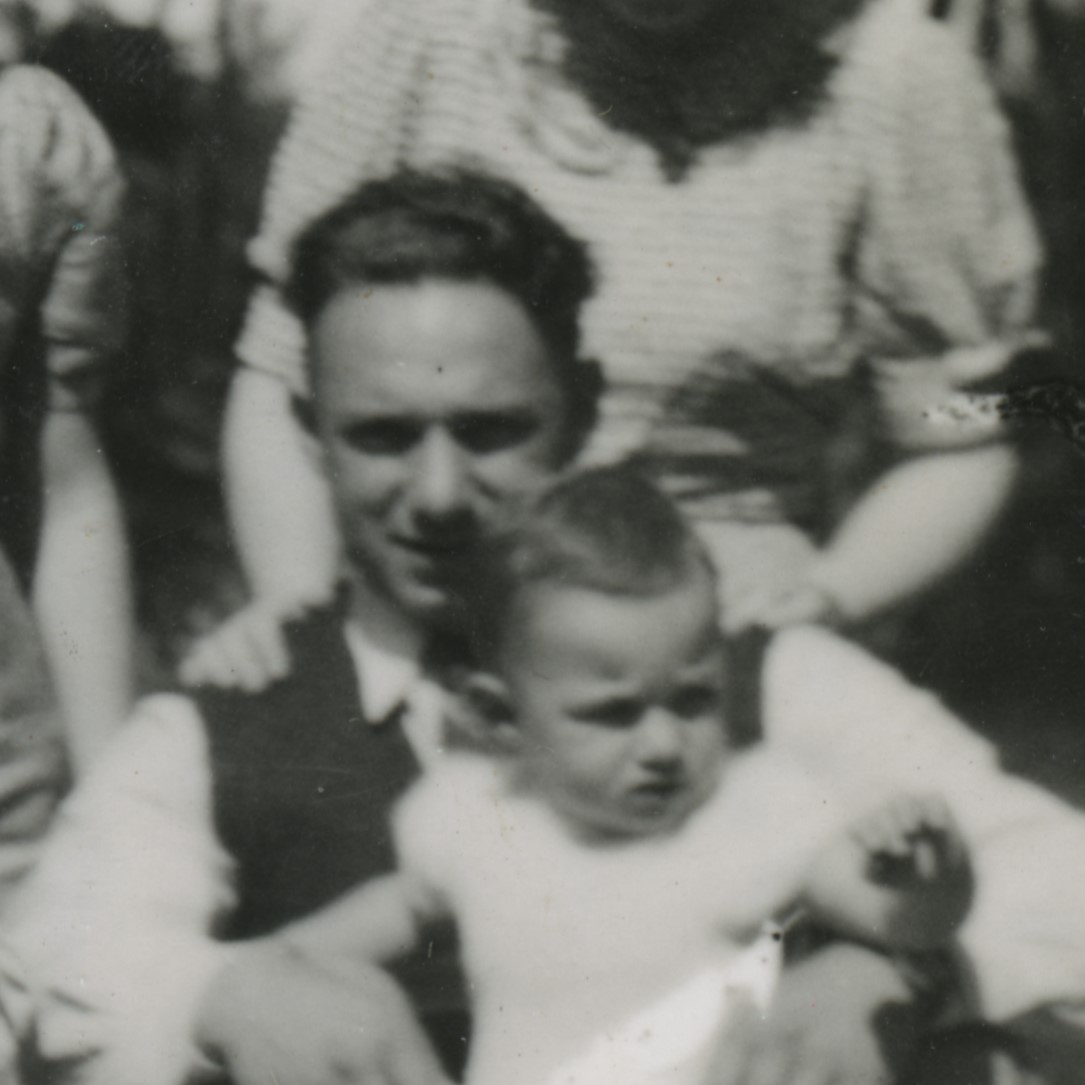Heinz Kaempfer
Heinz Kaempfer was a cousin of Anne Frank's friend Sanne Ledermann.
Heinz Kaempfer was the eldest son of Käthe Ledermann, a sister of Franz Ledermann, and lawyer Felix Kaempfer from Posen. He had a younger brother Otto Hans, who was born on 18 September 1906, but died on 19 October 1918 at the age of 13 after a serious illness.[1] Heinz moved to Berlin with his parents in 1920[2] and continued his schooling there. After graduating from the Prinz-Heinrichs-Gymnasium, he wanted to become a businessman.
Heinz's father died shortly after moving to Berlin, after which Heinz continued to live with his mother on the Potsdammerstraße.[3] On 4 June 1936, he married Eva Wrzeszinski, daugher of a Berlin lawyer.[1] Shortly afterwards, the couple settled in The Hague, where Heinz was registered as a merchant in etchings. Two years later, Heinz Kaempfer tried to get his mother to come to the Netherlands. Initially, the request was rejected but she was granted permission for a temporary stay on 14 November 1938.[4]
The Kaempfer family had a son Raymond (Ray), who was born in The Hague on 4 March 1940.[5] Because the family had to leave the coastal region, Kaempfer rented the house Op den Driest in Beekbergen in 1941. Family and friends could come and spend their holidays there, which also became a source of income.[6] Anne Frank spent some time there in 1941 with the family of her friend Sanne Ledermann. There are several photos of that holiday.[7] Heinz Kaempfer is in two of them and according to the captions, Anne called him "Uncle Heinz".[8]
In 1942, the deportations of the Jews began and the Kaempfers realized that they were no longer safe: they went into hiding in the west of the country. A few months later, father Heinz was betrayed and sent to Westerbork, but he was one of the few who left the camp alive after its liberation in 1945.[9] Eva, who was also discovered, survived Camp Vught. Little Ray, who had lived separated from his parents at seven different addresses for three years, was reunited with both his parents in July 1945.[10] He no longer recognized them. He would later say: "They were strangers to me. I hadn't seen them since I was two years old and I didn't even know what had happened to me."[11] In 1946, Ray's brother was born.
Kähte, Heinz's mother, also went into hiding. In October 1942, the Police Commissioner in Apeldoorn requested that she be located, arrested and brought to trial. She lived in Apeldoorn, but was suspected of having changed her place of residence without having the required permit. This description usually referred to Jews who had gone into hiding.[12] She was eventually arrested and ended up 'via Schevingen' in Westerbork transit camp.[13] An interesting detail is that Jenny Kaiser-Fischer, Eva Wrzeszinski's grandmother, was arrested almost at the same time and also ended up in Westerbork 'via Scheveningen'. They may have received a hiding address via the same network and this address was subsequently discovered or betrayed.[14] on 16 November 1943, both were deported to Auschwitz, where they were murdered on 19 November.
In the postwar years, Heinz Kaempfer was involved with the Society for Japanese Arts and Crafts (now the Society for Japanese Art), founded in 1937. His love for Japanese art seems to have started in Berlin in an art gallery on Pariser Platz, where in 1931 a major exhibition of Japanese art took place. In his role as secretary and chairman of the association, he played a prominent role in the promotion and appreciation of Japanese art. He is the namesake of the Heinz M. Kaempfer Fund, founded in 1989, which aims to promote and make accessible the study of the arts of Japan.[15]
Heinz Kaempfer died in 1986.
Source personal data.[16] Addresses: Potsdamer Strasse 109, Berlin;[3] Sijzenlaan 55, The Hague (June 1936);[17] Westzeedijk 108a, Rotterdam (Aug. 1936), Van der Aastraat 80, The Hague (October 1936);[18] Koningsweg 5, Beekbergen.[6]
Footnotes
- a, b Paul Enck, Die Familie von Franz Ledermann (Teil 4), Mittendran, 11 februari 2023.
- ^ Het schijnt dat zij werden gedwongen Posen te verlaten vanwege de deutsche Gesinnung van Kaempfer. Enck, Die Familie von Franz Ledermann.
- a, b Jüdisches Adressbuch für Gross – Berlin. Ausgabe 1931, Berlijn: arani-Verlag GmbH, 1994, p. 190.
- ^ Nationaal Archief, Den Haag, Verbaalarchief Ministerie van Justitie (1853) 1915 – 1955 (1963) (toegang 2.09.22), inv nr. 14812: Agenda 2e Afdeeling A, 1938 Q, volgnr. 2798.
- ^ “Burgerlijke Stand”, De Standaard. Haagsche Editie, 5 maart 1940.
- a, b Anne Frank Stichting (AFS), Getuigenarchief Kaempfer, Raymond: Aantekeningen telefoongesprek van AFS (Yt Stoker?) met R. Kaempfer, 9 november 2006.
- ^ AFS, Anne Frank Collectie (AFC), reg. code A-AFrank_III_055.123 t/m A-AFrank_III_055.130: 8 foto's uit fotoalbum 'Blanco Monster Electro Huishoudboek 1937', p. 47-49.
- ^ AFS, AFC, reg. code A_AFrank_III_055.126 en 127: Fotoalbum ‘Blanco Monster Electro Huishoudboek 1937’, p. 48-49.
- ^ Kamp Westerbork, Digitale collectie: Sonderausweis van Heinz Kaempfer.
- ^ Stichting 4 en 5 mei Beekbergen: Logeeradres Anne Frank.
- ^ Teresa Serafim, Raymond Kaempfer sobreviveu ao Holocausto em criança e agora combate armas biológicas, Público, 27 oktober 2018.
- ^ Joods Monument: Kaethe Jadwiga Kaempfer-Ledermann.
- ^ Arolsen Archives - International Center on Nazi Perscution, Bad Arolsen: Joodsche Raad Kaart Kathe Kämpfer Ledermann, DocID 130315471.
- ^ Joods Monument: Jenny Kaiser-Fischer.
- ^ Anna Beerens, Verschil maken op een bescheiden manier: Het Heinz M. Kaempfer Fund, Katern: Japan, 22 juni 2021; Society for Japanese Arts: About Heinz Kaempfer Fund.
- ^ Stadsarchief Rotterdam (SAR), Gemeentesecretarie Rotterdam, afdeling Bevolking, Bevolkingsboekhouding Rotterdam en geannexeerde gemeenten (toegang 494-03), inv. nr. 851-228: Gezinskaart H. Kaempfer; AFS, Getuigenarchief Kaempfer, Raymond: Aantekeningen telefoongesprek van AFS (Yt Stoker?) met R. Kaempfer, 9 november 2006.
- ^ Haags Gemeentearchief, Den Haag Bevolkingsregister Den Haag Kaas – Kaffa (toegang 0354-01.0590): gezinskaart Heinz Kaempfer.
- ^ SAR, Bevolkingsboekhouding, inv. nr. 851-228: gezinskaart Kaempfer.
